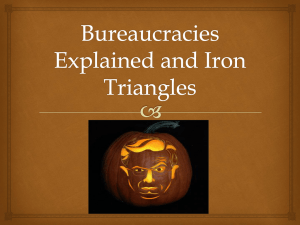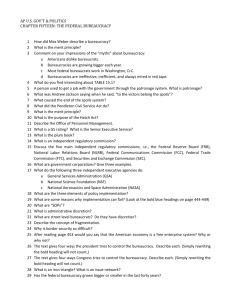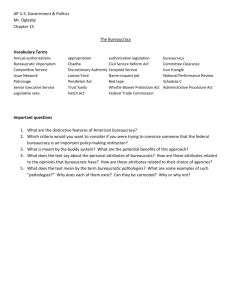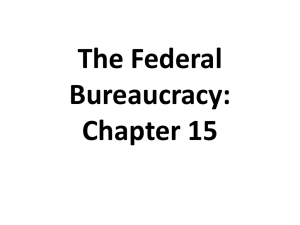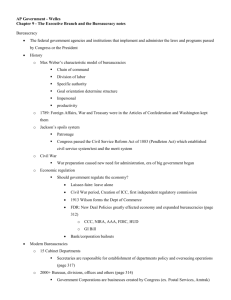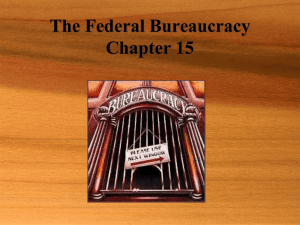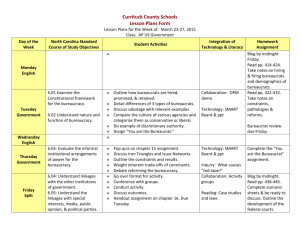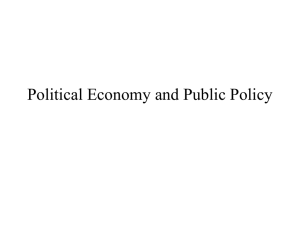(a hiring and promotion system based on knowing the right people).
advertisement
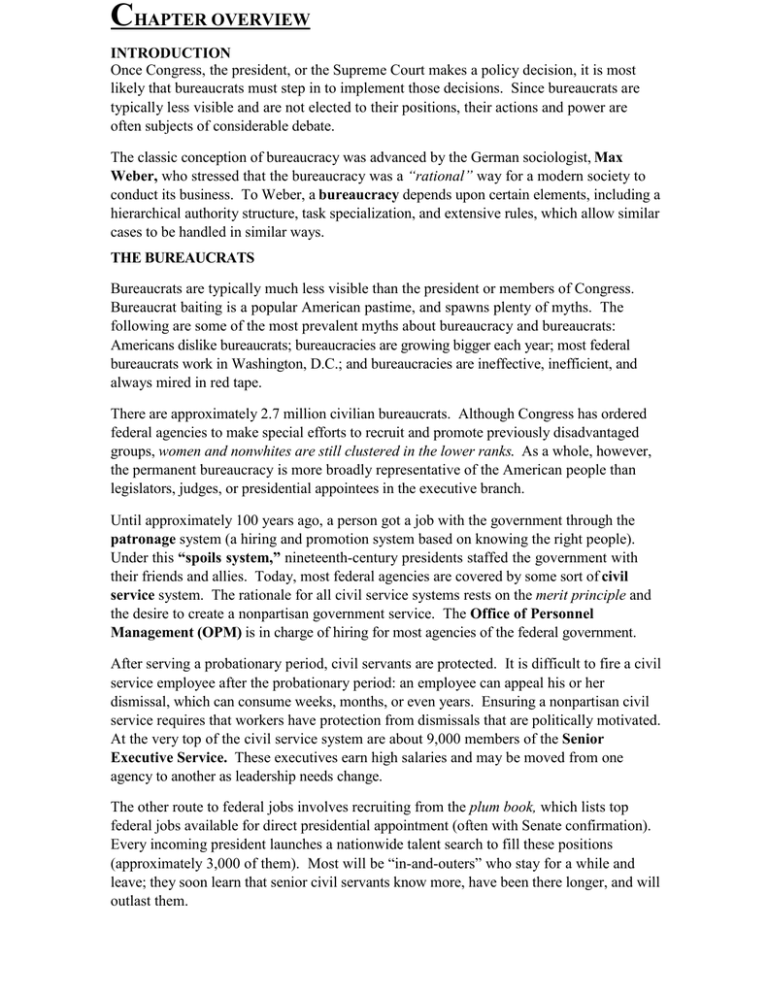
CHAPTER OVERVIEW INTRODUCTION Once Congress, the president, or the Supreme Court makes a policy decision, it is most likely that bureaucrats must step in to implement those decisions. Since bureaucrats are typically less visible and are not elected to their positions, their actions and power are often subjects of considerable debate. The classic conception of bureaucracy was advanced by the German sociologist, Max Weber, who stressed that the bureaucracy was a “rational” way for a modern society to conduct its business. To Weber, a bureaucracy depends upon certain elements, including a hierarchical authority structure, task specialization, and extensive rules, which allow similar cases to be handled in similar ways. THE BUREAUCRATS Bureaucrats are typically much less visible than the president or members of Congress. Bureaucrat baiting is a popular American pastime, and spawns plenty of myths. The following are some of the most prevalent myths about bureaucracy and bureaucrats: Americans dislike bureaucrats; bureaucracies are growing bigger each year; most federal bureaucrats work in Washington, D.C.; and bureaucracies are ineffective, inefficient, and always mired in red tape. There are approximately 2.7 million civilian bureaucrats. Although Congress has ordered federal agencies to make special efforts to recruit and promote previously disadvantaged groups, women and nonwhites are still clustered in the lower ranks. As a whole, however, the permanent bureaucracy is more broadly representative of the American people than legislators, judges, or presidential appointees in the executive branch. Until approximately 100 years ago, a person got a job with the government through the patronage system (a hiring and promotion system based on knowing the right people). Under this “spoils system,” nineteenth-century presidents staffed the government with their friends and allies. Today, most federal agencies are covered by some sort of civil service system. The rationale for all civil service systems rests on the merit principle and the desire to create a nonpartisan government service. The Office of Personnel Management (OPM) is in charge of hiring for most agencies of the federal government. After serving a probationary period, civil servants are protected. It is difficult to fire a civil service employee after the probationary period: an employee can appeal his or her dismissal, which can consume weeks, months, or even years. Ensuring a nonpartisan civil service requires that workers have protection from dismissals that are politically motivated. At the very top of the civil service system are about 9,000 members of the Senior Executive Service. These executives earn high salaries and may be moved from one agency to another as leadership needs change. The other route to federal jobs involves recruiting from the plum book, which lists top federal jobs available for direct presidential appointment (often with Senate confirmation). Every incoming president launches a nationwide talent search to fill these positions (approximately 3,000 of them). Most will be “in-and-outers” who stay for a while and leave; they soon learn that senior civil servants know more, have been there longer, and will outlast them. HOW BUREAUCRACIES ARE ORGANIZED In general, there are four types of bureaucracies: cabinet departments, regulatory agencies, government corporations, and independent executive agencies. Each of the 15 cabinet departments is headed by a secretary (except the Department of Justice, which is headed by the attorney general); all are chosen by the president and approved by the Senate. Beneath the secretary are undersecretaries, deputy undersecretaries, and assistant secretaries. Each department manages specific policy areas, and each has its own budget and staff. Each of the independent regulatory commissions has responsibility for some sector of the economy. Regulatory agencies make and enforce rules designed to protect the public interest; they also judge disputes over those rules. Government corporations provide a service that could be handled by the private sector. They typically charge for their services, though often at cheaper rates than the consumer would pay a private sector producer. The independent executive agencies are not part of the cabinet departments and generally do not have regulatory functions. They usually perform specialized functions. BUREAUCRACIES AS IMPLEMENTORS As policymakers, bureaucrats play three key roles: they are policy implementers; they administer public policy; and they are regulators. Policy implementation occurs when the bureaucracy carries out decisions of Congress, the president, and even the courts. Public policies are rarely self-executing: bureaucrats translate legislative policy goals into programs. Policy implementation does not always work well, and bureaucrats usually take the blame when it does not. Reasons why implementation may break down include faulty program design, lack of clarity in the laws bureaucrats administer, lack of resources, the following of standard operating procedures, administrative discretion, and dispersal of policy responsibility among several units of the bureaucracy (i.e., fragmentation). Administrative discretion is the authority of administrative actors to select among various responses to a given problem. Discretion is greatest when rules do not fit a case; but even in agencies with elaborate rules and regulations—especially when more than one rule fits— there is still room for discretion. Michael Lipsky coined the phrase street-level bureaucrats to refer to those bureaucrats who are in constant contact with the public and have considerable discretion (including police officers, welfare workers, and lower court judges). Fragmentation has resulted in the responsibility for a policy being dispersed among several units within the bureaucracy. PRIVATIZATION Since the 1980s efforts have been made to decentralize authority and provide performance incentives through market competition and competitive public-versus-private bidding on government services. Although contracting for services is meant to result in better service and lower costs, there is no evidence that private contractors have provided services more efficiently at the federal level. Furthermore, contracting almost always leads to less public scrutiny. BUREAUCRACIES AS REGULATORS Government regulation is the use of governmental authority to control or change some practice in the private sector. This is the most controversial role of the bureaucracies, yet Congress gives them broad mandates to regulate activates as diverse as interest rates, the location of nuclear power plants, and food additives. Until 1887, the federal government made almost no regulatory policies. Even the minimum regulatory powers of state and local governments were disputed. In 1887, Congress created the first regulatory agency, the Interstate Commerce Commission (ICC), charged with regulating the railroads, their prices, and their services to farmers. Most agencies charged with regulation first have to develop a set of rules (often called guidelines); guidelines are developed in consultation with (and sometimes with the agreement of) the people or industries being regulated. The agency must then apply and enforce its rules and guidelines, either in court or through its own administrative procedures. Almost every regulatory policy was created to achieve some desirable social goal. Charles L. Schultze (chairman of President Carter’s Council of Economic Advisors) is a critic of the current state of federal regulation, which he described as command-and-control policy: the government tells business how to reach certain goals, checks that these commands are followed, and punishes offenders. Schultze prefers an incentive system. Defenders of the command-and-control system of regulation compare it to preventive medicine; it is designed to minimize problems such as pollution or workplace accidents before they become too severe. Government regulation of the American economy and society has grown in recent decades. The budgets of regulatory agencies, their level of employment, and the number of rules they issue are all increasing. Opponents of government regulation contend that the rapid increase in the number and scope of environmental regulations during the past two decades has stifled economic growth. Supporters of government regulation argue that such regulations are essential to protect the nation’s air, land, and water (and the people who use it). The idea behind deregulation, the lifting of government restrictions on business, industry, and professional activities, is that the number and complexity of regulatory policies have made regulation too complicated and burdensome. To critics, the problem with regulation is that it raises prices, distorts market forces, and worst of all it does not work. Not everyone, however, believes that deregulation is in the nation’s best interest. Many regulations have proved beneficial to Americans. As a result of government regulations, we breathe cleaner air, we have lower levels of lead in our blood, miners are safer at work, seacoasts have been preserved, and children are more likely to survive infancy. UNDERSTANDING BUREAUCRACIES In democratic theory, popular control of government depends on elections, but we could not possibly elect the more than four million federal civilian and military employees (or even the few thousand top men and women). However, the fact that voters do not elect civil servants does not mean that bureaucracies cannot respond to and represent the public’s interests. Much depends on whether bureaucracies are effectively controlled by the policymakers that citizens do elect—the president and Congress. Some presidential methods of exercising control over bureaucracies include: • Appointing the right people to head the agency. Issuing executive orders. • Tinkering with an agency’s budget. Reorganizing an agency. • There are several measures Congress can take to oversee the bureaucracy: • Influencing the appointment of agency heads. Tinkering with an agency’s budget. Holding hearings. Rewriting the legislation or making it more detailed. • • • One crucial explanation for the difficulty presidents and Congress face in controlling bureaucracies relates to the role of iron triangles and issue networks. When agencies, groups, and committees all depend on one another and are in close, frequent contact, they form iron triangles (or subgovernments). Iron triangles have dominated some areas of domestic policymaking by combining internal consensus with a virtual monopoly on information in their area. Iron triangles are characterized by mutual dependency, in which each element provides key services, information, or policy for the others (illustrated by the tobacco triangle). These subgovernments can add a strong decentralizing and fragmenting element to the policymaking process. Hugh Heclo points out that the system of subgovernments is now overlaid with an amorphous system of issue networks, which means that there is more widespread participation in bureaucratic policymaking, and many of the participants have technical policy expertise and are drawn to issues because of intellectual or emotional commitments rather than material interests. This opening of the policymaking process complicates the calculations and decreases the predictability of those involved in the stable and relatively narrow relationships of subgovernments. Despite the fact that subgovernments often are able to dominate policymaking for decades, they are not indestructible; policies of the tobacco triangle, for one, have increasingly come under fire from health authorities. The federal bureaucracy has not grown over the past two generations. In fact, the bureaucracy has shrunk in size relative to the population it serves. Originally, the federal bureaucracy had a modest role, but as the economy and the society of the United States changed, additional demands were made on government. Considering the more active role the bureaucracy is expected to play in dealing with social and economic problems, a good case can be made that the bureaucracy is actually too small for many of the tasks currently assigned to it (such as the control of illicit drugs or the protection of the environment). CHAPTER OUTLINE I. THE WEBERIAN MODEL OF BUREAUCRACIES A. The classic conception of bureaucracy was advanced by the German sociologist, Max Weber, who stressed that the bureaucracy was a “rational” way for a modern society to conduct its business. B. To Weber, a bureaucracy depends upon certain elements. 1. It has a hierarchical authority structure, in which power flows from the top down and responsibility from the bottom up. 2. It uses task specialization, so experts instead of amateurs perform technical jobs. 3. It develops extensive rules, which allow similar cases to be handled in similar ways. C. Bureaucrats work on the merit principle, in which entrance and promotion are on the basis of demonstrated abilities. D Bureaucracies behave with impersonality so that all clients are treated impartially. II. THE BUREAUCRATS A. Bureaucratic agencies. 1. Each bureaucratic agency is created by Congress, which sets its budget and writes the policies it administers. 2. Most agencies are responsible to the president, whose administrative responsibilities are only vaguely hinted at in the constitutional obligation “to take care that the laws shall be faithfully executed.” 3. How to manage and control bureaucracies is a central problem of democratic government. B. Bureaucrats have been the scapegoats of American politics. Following are some of the most prevalent myths (and responses): 1. Americans dislike bureaucrats. Despite the rhetoric about bureaucracies, Americans are generally satisfied with bureaucrats and the treatment they get from them. 2. Most federal bureaucrats work in Washington, D.C. Only about 12 percent of federal civilian employees work in Washington. 3. 4. Bureaucracies are growing bigger each year. Almost all the growth in the number of public employees has occurred in state and local governments. As a percentage of America’s total work force, federal government employment has actually been shrinking and now amounts to about three percent of all civilian jobs. Bureaucracies are ineffective, inefficient, and always mired in red tape. Bureaucracy is simply a way of organizing people to perform work. Bureaucracies may be inefficient at times, but no one has yet demonstrated that government bureaucracies are more or less inefficient, ineffective, or mired in red tape than private bureaucracies. C. Bureaucrats do much more than simply follow orders. 1. Bureaucrats possess crucial information and expertise that make them partners with the president and Congress in making decisions about public policy. 2. Those that compose the bureaucracy perform most of the vital services provided by the federal government. 3. Despite all the complaints about bureaucracies, the vast majority of tasks carried out by governments at all levels are noncontroversial. 4. Bureaucrats perform a wide variety of routine governmental tasks in a perfectly acceptable manner. 5. Because of their expertise, they inevitably have some discretion in carrying out policy decisions. D. Federal employment. 1. The Department of Defense (DOD) employs about one-fourth of federal civilian workers in addition to the 1.4 million men and women in uniform. Altogether, the DOD makes up more than half of the federal bureaucracy. 2. The Postal Service accounts for an additional 28 percent of federal civilian employees. 3. The Department of Veterans Affairs (clearly related to national defense) has more than 253,000 employees 4. All other functions of government are handled by the remaining 25 percent of federal employees. E. Who they are and how they got there. 1. There are approximately 2.7 million civil bureaucrats (more than 21 million if state and local public employees are included). 2. Although Congress has ordered federal agencies to make special efforts to recruit and promote previously disadvantaged groups, women and nonwhites are still clustered in the lower ranks. 3. As a whole, the permanent bureaucracy is more broadly representative of the American people than legislators, judges, or presidential appointees in the executive branch. 4. The diversity of employees in bureaucratic jobs mirrors the diversity of private sector jobs. F. Civil service: from patronage to protection. 1. Until approximately 100 years ago, a person got a job with the government through the patronage system (a hiring and promotion system based on knowing the right people). a. Under this “spoils system,” nineteenth-century presidents staffed the government with their friends and allies. b. In a tragic irony of history, Charles Guiteau (a disappointed office seeker) actually helped end this system of federal appointments: frustrated because President James A. Garfield would not give him a job, Guiteau shot and killed the president. c. Vice President Chester A. Arthur (who then became president) surprised his critics by pushing for passage of the Pendleton Civil Service Act (1883), which created the federal Civil Service. 2. Today, most federal agencies are covered by some sort of civil service system. 3. The rationale for all civil service systems rests on the idea of merit and the desire to create a nonpartisan government service. a. The merit principle (using examinations and promotion ratings) is intended to produce administration by people with talent and skill. b. Creating a nonpartisan civil service means insulating government workers from the risk of being fired when a new party comes to power. c. The Hatch Act (1939, amended 1993) also prohibits those employees from active participation in partisan politics. 4. The Office of Personnel Management (OPM) is in charge of hiring for most agencies of the federal government. a. For each position that is open, the OPM will send three names to the agency (known as the rule of three). b. Once hired, a person is assigned a GS (General Schedule) rating, ranging from GS 1 to GS 18. 5. 6. c. After a probationary period, civil servants are protected; it is difficult to fire a civil service employee after the probationary period. An employee can appeal his or her dismissal, which can consume weeks, months, or even years. (The right of appeal must be exhausted before one’s paycheck stops.) (1) Ensuring a nonpartisan civil service requires that workers have protection from dismissals that are politically motivated. (2) Protecting all workers against political firings may also protect a few from dismissal for good cause. At the very top of the civil service system are about 9,000 members of the Senior Executive Service. These executives earn high salaries and may be moved from one agency to another as leadership needs change. The other route to federal jobs: recruiting from the plum book. a. Congress publishes the plum book, which lists top federal jobs available for direct presidential appointment (often with Senate confirmation). b. Every incoming president launches a nationwide talent search to fill these positions (approximately 3,000 of them). c. Presidents look for individuals who combine executive talent, political skills, and policy views similar to those of the president. d. Some positions—especially ambassadorships—go to large campaign contributors. e. Most will be political appointees, “in-and-outers,” who stay for a while and then leave; they soon learn that senior civil servants know more, have been there longer, and will outlast them. f. Most find it difficult to exercise real control over much of what their subordinates do: the security of the civil servants’ jobs combined with the transience (and even ignorance) of their superiors contribute to the bureaucracy’s resistance to change. III. HOW BUREAUCRACIES ARE ORGANIZED A. In general, there are four types of bureaucracies: cabinet departments, regulatory agencies, government corporations, and independent executive agencies. B. The cabinet departments. 1. Each of the 15 cabinet departments is headed by a secretary (except the Department of Justice, which is headed by the attorney general); all are chosen by the president and approved by the Senate. a. Beneath the secretary are undersecretaries, deputy undersecretaries, and assistant secretaries. b. Each department manages specific policy areas, and each has its own budget and staff. 2. The real work of a department is done in the bureaus (sometimes designated by other names such as service, office, or administration). 3. From the 1970s until 1995, the Department of Health and Human Services was the largest federal department in dollars spent (although the Department of Defense still had more employees). The Social Security Administration became an independent agency in 1995, spending one-third of the federal budget on the massive programs of Social Security and Medicare. C. The regulatory commissions. 1. Each of the independent regulatory commissions has responsibility for some sector of the economy, making and enforcing rules designed to protect the public interest; they also judge disputes over those rules. 2. They are sometimes called the “alphabet soup” of American government because most such agencies are known by their initials: ICC (Interstate Commerce Commission), FRB (Federal Reserve Board), NLRB (National Labor Relations Board), FCC (Federal Communications Commission), FTC (Federal Trade Commission), SEC (Securities and Exchange Commission). 3. Each of the agencies is governed by a small commission, appointed by the president for fixed terms of office and confirmed by the Senate; regulatory commission members cannot be fired by the president. 4. Critics claim that the close connection between the regulators and the industries they regulate has meant that the agencies have become the “captives” of industry. D. The government corporations. 1. 2. 3. Government corporations provide a service that could be handled by the private sector. They typically charge for their services, though often at cheaper rates than the consumer would pay a private sector producer. Examples include the Tennessee Valley Authority (TVA), Amtrak, and the Federal Deposit Insurance Corporation (FDIC). The U.S. Postal Service is the largest of the government corporations. E. The independent executive agencies. 1. The independent executive agencies are not part of the cabinet departments and generally do not have regulatory functions; they usually perform specialized functions. 2. Their administrators are typically appointed by the president and serve at his pleasure. 3. Examples include the General Services Administration (GSA), National Science Foundation (NSF), and National Aeronautics and Space Administration (NASA). IV. BUREAUCRACIES AS IMPLEMENTORS A. As policymakers, bureaucrats play three key roles: they are policy implementors; they administer public policy; and they are regulators. B. Policy implementation occurs when the bureaucracy carries out decisions of Congress, the president, and even the courts. 1. Public policies are rarely self-executing: bureaucrats translate legislative policy goals into programs. 2. Congress typically announces the goals of a policy in broad terms, sets up an administrative apparatus, and leaves the bureaucracy the task of working out the details of the program. C. Three elements of implementation: 1. Creation of a new agency or assignment of responsibility to an old one. 2. Translation of policy goals into operational rules of thumb and development of guidelines. 3. Coordination of resources and personnel to achieve the intended goals. D. Reasons why implementation may break down (policy implementation does not always work well, and bureaucrats usually take the blame when it does not): 1. Faulty program design: a policy or program may be defective in its basic theoretical conception. 2. Lack of clarity: bureaucracies are often asked to implement unclear laws; members of Congress can thus escape the messy details, and blame for the implementation decisions can be placed elsewhere. Title IX of the Education Act of 1972 is a good example of how implementation becomes complex if the original legislation is unclear. 3. Lack of resources: as big as bureaucracy may appear, it frequently lacks the staff (along with the necessary training, funding, supplies, and equipment) to carry out the tasks it has been assigned to do; agencies may also lack the authority to meet their responsibilities. 4. Administrative routine: much of administration involves a routine in which bureaucrats follow standard operating procedures (SOPs) to help them make numerous everyday decisions. a. SOPs bring uniformity to complex organizations. b. Justice is better served if rules are applied uniformly. c. Uniformity also makes personnel interchangeable. d. Routines are essential to bureaucracy (but they also become frustrating to citizens, who term them “red tape” when they do not appear to appropriately address a situation, and may become obstacles to action). 5. Administrators’ dispositions: paradoxically, bureaucrats operate not only within the confines of routines but often with considerable discretion to behave independently. a. Administrative discretion is the authority of administrative actors to select among various responses to a given problem. b. Discretion is greatest when rules do not fit a case; but even in agencies with elaborate rules and regulations—especially when more than one rule fits—there is still room for discretion. c. Michael Lipsky coined the phrase street-level bureaucrats to refer to those bureaucrats who are in constant contact with the public and have considerable discretion (including police officers, welfare workers, and lower court judges). d. How bureaucrats exercise discretion depends on their dispositions about the policies and rules they administer; although bureaucrats may be indifferent to the implementation of many policies, others will be in conflict with their policy views or personal or organizational interests. e. Controlling the exercise of discretion is a difficult task: it is not easy to fire bureaucrats in the Civil Service, and removing appointed officials may be politically embarrassing to the president. 6. Fragmentation: responsibility for a policy is sometimes dispersed among several units within the bureaucracy. a. This diffusion of responsibility makes the coordination of policies both time-consuming and difficult. b. Sometimes those who are supposed to administer a law receive contradictory signals from different agencies. c. President George W. Bush’s creation of the Office of Homeland Security in 2001 involved directing the counterterrorism efforts of 46 federal agencies, encompassing much of the federal government. d. Hyperpluralism and the decentralization of power make it difficult to reorganize government. V. PRIVATIZATION A. Since the 1980s efforts have been made to decentralize authority and provide performance incentives through market competition and competitive publicversus-private bidding on government services. B. The theory behind contracting for services is that competition in the private sector will result in better service at lower costs. C. Critics of contracting argue: 1. There is no evidence that private contractors have provided services more efficiently at the federal level. 2. Competition is not always present. 3. Contracting almost always leads to less public scrutiny. VI. BUREAUCRACIES AS REGULATORS A. Regulation in the economy and in everyday life. 1. Government regulation is the use of governmental authority to control or change some practice in the private sector. 2. This is the most controversial role of the bureaucracies, yet Congress gives them broad mandates to regulate activities as diverse as interest rates, the location of nuclear power plants, and food additives. 3. Everyday life itself is the subject of bureaucratic regulation; almost all bureaucratic agencies—not merely the ones called independent regulatory agencies—are in the regulatory business. 4. Most government regulation is clearly in the public interest. For example, the U.S. Department of Agriculture is charged with regulating the quality of meat products. B. Regulation: how it grew, how it works. 1. Until 1887, the federal government made almost no regulatory policies. a. Even the minimum regulatory powers of state and local governments were disputed. b. In 1877, the Supreme Court upheld the right of government to regulate the business operations of a firm (Munn v. Illinois). c. In 1887, Congress created the first regulatory agency, the Interstate Commerce Commission (ICC), charged with regulating the railroads, their prices, and their services to farmers. 2. Most agencies charged with regulation first have to develop a set of rules (often called guidelines); guidelines are developed in consultation with (and sometimes with the agreement of) the people or industries being regulated. 3. The agency must then apply and enforce its rules and guidelines, either in court or through its own administrative procedures. a. Sometimes it waits for complaints to come to it (as the Equal Employment Opportunity Commission does). b. Sometimes it sends inspectors into the field (as the Occupational Safety and Health Administration does). 4. c. Sometimes it requires applicants for a permit or license to demonstrate performance consistent with congressional goals and agency rules (as the Federal Communications Commission does). All regulation contains these elements: a. A grant of power and set of directions from Congress. b. A set of rules and guidelines by the regulatory agency itself. c. Some means of enforcing compliance with congressional goals and agency regulations. C. How should we regulate? D. Government regulation of the American economy and society has grown in recent decades. 1. The budgets of regulatory agencies, their level of employment, and the number of rules they issue are all increasing—and did so even during the Reagan administration. E. Toward deregulation. 1. The idea behind deregulation is that the number and complexity of regulatory policies have made regulation too complex and burdensome. 2. Critics of regulation have a number of accusations against the regulatory system. a. It raises prices. b. It hurts America’s competitive position abroad. c. It does not always work well. F. Critics of deregulation. 1. Critics of deregulation point to severe environmental damage resulting from lax enforcement of environmental protection standards during the Reagan administration. 2. Many observers attribute at least a substantial portion of the blame for the enormously expensive bailout of the savings and loan industry to the deregulation of it in the 1980s. VI. UNDERSTANDING BUREAUCRACIES A. Bureaucracy and democracy. 1. In democratic theory, popular control of government depends on elections, but we could not possibly elect the 4.1 million federal civilian and military employees (or even the few thousand top men and women). 2. The fact that voters do not elect civil servants does not mean that bureaucracies cannot respond to and represent the public’s interests. 3. Much depends on whether bureaucracies are effectively controlled by the policymakers that citizens do elect—the president and Congress. a. Presidents try to impose their policy preferences on agencies, using some of the following methods: (1) Appoint the right people to head the agency: putting their people in charge is one good way for presidents to influence agency policy. (2) Issue orders: Presidents can issue executive orders to agencies, or presidential aides can pass the word that “the president was wondering if . . .” (3) Tinker with an agency’s budget: the Office of Management and Budget is the president’s own final authority on any agency’s budget, but each agency has its own constituents within and outside of Congress, and it is Congress that appropriates funds. (4) Reorganize an agency: although President Reagan promised to abolish the Department of Energy and the Department of 4. Education, he never succeeded—largely because each was in the hands of an entrenched bureaucracy, backed by elements in Congress and strong constituent groups. b. Congress exhibits an ambivalent relationship with the bureaucracies: (1) On the one hand, members of Congress may find a big bureaucracy congenial (big government provides services to constituents). (2) On the other hand, Congress has found it hard to control the government it helped create. c. Measures Congress can take to oversee the bureaucracy: (1) Influence the appointment of agency heads: even when senatorial approval of a presidential appointment is not required, members of Congress may be influential. (2) Tinker with an agency’s budget: the congressional power of the purse is a powerful weapon for controlling bureaucratic behavior. (3) Hold hearings: committees and subcommittees can hold periodic hearings as part of their oversight job. (4) Rewrite the legislation or make it more detailed: Congress can write new or more detailed legislation to limit bureaucratic discretion and make its instructions clearer. There is one other crucial explanation for the difficulty presidents and Congress face in controlling bureaucracies: iron triangles and issue networks. a. When agencies, groups, and committees all depend on one another and are in close, frequent contact, they form iron triangles (or subgovernments). b. Iron triangles have dominated some areas of domestic policymaking by combining internal consensus with a virtual monopoly on information in their area. c. Iron triangles are characterized by mutual dependency, in which each element provides key services, information, or policy for the others (illustrated by the tobacco triangle). d. These subgovernments can add a strong decentralizing and fragmenting element to the policymaking process. e. Heclo points out that the system of subgovernments is now overlaid with a system of issue networks, with more widespread participation in bureaucratic policymaking, and many of the participants have technical policy expertise and are drawn to issues because of intellectual or emotional commitments rather than material interests. This opening of the policymaking process decreases the predictability of those involved in the stable and relatively narrow relationships of subgovernments. f. Despite the fact that subgovernments often are able to dominate policymaking for decades, they are not indestructible. Policies of the tobacco triangle, for one, have increasingly come under fire from health authorities. B. Bureaucracy and the scope of government. 1. The federal bureaucracy has not grown over the past two generations; in fact, the bureaucracy has shrunk in size relative to the population it serves. 2. Originally, the federal bureaucracy had a modest role; but as the economy and the society of the United States changed, additional demands were made on government. (See Chapter 3.) 3. Considering the more active role the bureaucracy is expected to play in dealing with social and economic problems, a good case can be made that the bureaucracy is actually too small for many of the tasks currently assigned to it (such as the control of illicit drugs or the protection of the environment).
